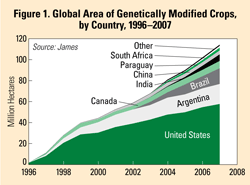Genetically Modified Crops are 9 Percent of Primary Global Crop
Production
In 2007, farmers planted an additional 12.3 million hectares of
genetically modified (GM) crops, bringing the total global GM crop
area up 12 percent, to 114.3 million hectares. Although GM crops have
been on the market for a decade, they currently account for a modest 9
percent of total land used for global primary crops.
This new Vital Signs trend on genetically modified crops includes
detailed figures on GM crop area across the world as well as an
analysis of surrounding issues. It shows that:
- Four cash crops continue to account for virtually all GM
production: soybeans, corn, cotton, and canola.
- The United States continues to be the leader in GM crop planted
area.
- China added 300,000 new hectares of GM crops in 2007, about
one-eighth as much as India added that year.
- Twenty-three countries were growing GM crops in 2007, including
17 high-income and upper-middle-income countries and 6
lower-middle-income countries.
Genetically modified crops (also called biotech crops) are
varieties that have been intentionally altered through genetic
engineering. They have been commercially available for ten years but
continue to be controversial, with disagreement about their potential
benefits and their role in a sustainable agriculture future. Most
recently, proponents have sought to pitch GM crops as a solution to
food security and climate change - even though most evidence suggests
otherwise.
Read the Vital Signs Update:
Genetically Modified Crops Only a Fraction of Primary Global Crop
Production
|
Worldwatch Institute - 1776 Massachusetts
Avenue, NW, Washington, DC 20036
Tel 202.452.1999 - Fax 202.296.7365 -
www.worldwatch.org |
|
